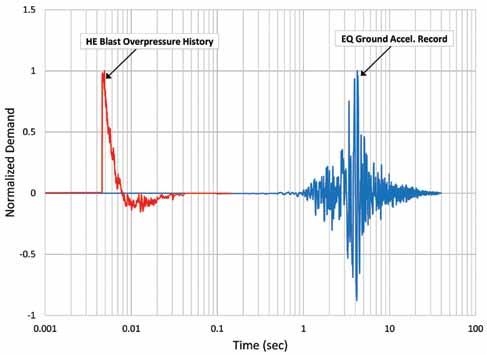
15 minute read
Structural Design
design issues for structural engineers
Over the past few decades, significant advances have been made in the areas of earthquake engineering and seismic design. A growing database of strong motion records, refined ground motion attenuation relationships, and probabilistic seismic hazard methodologies have led to an improved design basis for seismic events. In addition, multi-scale component-level and system-level research have given rise to innovative energy dissipation and kinematic isolation concepts, enhanced structural detailing provisions, and performance-based design methodologies. Perhaps most importantly, many of these technological advances are currently being implemented in practice and taught in colleges and universities. The protection of buildings against airblast due to explosions has been a national interest for many years. For at least half a century, the U.S. Government has invested in physical testing, research, and development efforts focused Design for Blast and Seismic on wartime defense scenarios involving both nuclear weapons Acknowledging Differences and high-explosive detonations. Moreover, the heavy industrial and Leveraging Synergies sector has long been concerned with damage and injury mitigation from accidental explosions By Eric L. Sammarco, P.E., M. ASCE, Cliff A. Jones, P.E., M. ASCE, Eric B. Williamson, Ph.D., P.E., M. ASCE and Harold O. Sprague, P.E., F. ASCE occurring in petrochemical facilities. With the rise in international and domestic terrorism, the vulnerability and state-of-security of the nation’s buildings and infrastructure have become national concerns. As a result, interest in blast effects and protective design has increased among the general structural engineering community. Recent public domain research has led to a number of significant technological advances related to blast threat mitigation and anti-terrorist/force protection (ATFP) design. Blast-resistant design guidance is available in specialized building design standards, handbooks, and guidance documents such as ASCE 59-11 Blast Protection of Buildings, UFC 4-010-01 DoD Minimum Anti-Terrorist Standards for Buildings, the compilation text entitled Handbook for Blast-Resistant Design of Buildings, and FEMA 427 Primer for Design of Commercial Buildings to Mitigate Terrorist Attacks. However, unlike earthquake engineering, the integration of fundamental blast-resistant analysis/design principles with the general structural engineering community and major college curricula has been slow at best. Consequently, understanding that blast and seismic are both dynamic phenomena, many structural engineers are left drawing from their seismic knowledge when faced with a blast-resistant analysis and/or design scenario. Extrapolating in this manner is ill-advised because an adequate seismic design does not necessarily imply adequacy from a blast-resistant design perspective. Recognizing the risk presented by unqualified engineers performing blast-resistant design, the United Kingdom has taken a proactive approach by initiating the Register of Security Engineers and Specialists (RSES) through the Institution of Civil Engineers. The Register aims to ensure that registrants have achieved a recognized competence standard, accepted a code of ethics, and are committed to continuing professional development. While no such specialized register or certification currently exists in the U.S., it is important for structural engineers to be mindful of the fact that design adequacy for one load case does not guarantee design adequacy for the other. As the title of this article suggests, there are important differences between seismic-resistant design and blast-resistant design, despite the dynamic nature of both. By acknowledging the differences and leveraging the synergies between the two design methodologies, structural engineers can improve the overall efficiency, effectiveness, and robustness of their building designs. This is not a new topic; however, past treatments have typically been cursory and fragmented. This article aims to provide a relatively comprehensive overview of the blast versus seismic topic by addressing demand, system response, component response, and design synergies in a practical way that will hopefully benefit the structural engineering community.
Differences from a Demand Perspective
Aside from the dynamic nature of both types of loads, earthquake ground motion characteristics are markedly different from those of a blast-induced overpressure history. Figure 1 (page 12) shows a comparison between a normalized ground acceleration record from the 1989 Loma Prieta earthquake and a normalized freefield overpressure history from a high-explosive (HE) detonation. The duration of an unconfined blast pulse from a high-explosive detonation is generally on the order of microseconds to milliseconds, whereas the strong motion duration of a typical earthquake record is generally on the order of several seconds and can last over a minute. In Figure 1, note the cyclic nature of the ground motion acceleration record, which includes multiple peaks. Conversely, for the blast overpressure history, note the nearly instantaneous rise to peak overpressure followed by a rapid decay to a subatmospheric “negative pressure” condition. Blast overpressure is often reported as a gauge pressure relative to ambient atmospheric conditions. Thus, a negative gauge pressure condition represents sub-atmospheric pressure, resulting in a temporary suction effect. Earthquake demand input is kinematic in nature, where near-field seismic waves excite continued on page 12
Figure 1: Comparison of typical demand input.
the foundation of an affected structure and engage its entire lateral force resisting system (LFRS). Seismic forces are derived from accelerating the mass of an affected structure and inducing relative displacements between structural components. In contrast, blast demand input is force-based in nature. A high-explosive detonation gives rise to a shock wave that impinges upon exposed surfaces of nearby structural components, imparting a highly transient reflected pressure pulse. The shock wave does not engage the affected structure’s entire LFRS at once; rather, its effect is phased in time and highly variable in magnitude. Finally, an important distinction can be made with regard to the origin of both demand inputs. Earthquakes are a naturally occurring phenomenon. Historical strong motion data and fault studies are
As a quick aside, ground motion spatial incoherence and soil-structure interaction effects are typically neglected in practice –high-importance structures such as nuclear power plants and mission-critical military facilities being exceptions. It is encouraged that such effects, particularly soil-structure interaction, be considered more frequently in practice as they are phenomena that do exist in reality and can strongly influence structural response in certain situations. The interested reader should consult NIST Report GCR 12-917-21 Soil-Structure Interaction for Building Structures for additional information. relatively abundant, which has led to the identification of statistical trends and development of probabilistic and deterministic approaches for predicting design basis demand input. In contrast, highexplosive detonations are often the result of an intentional act, and thus are regarded as being more of a random event. The man-made nature of these blast loads, coupled with the lack of meaningful statistical data relating geographic location or recurrence period to specific threat scenarios, has largely relegated blast engineers
Differences at the System Level
The primary difference between blast and seismic loading from a system response perspective is the area over which the load is distributed. Because seismic loads are a secondary effect of base excitation, they effectively engage the entire structure and require system response to resist the forces. In contrast, primary blast effects from an external detonation are typically localized, distressing isolated areas along the exterior of an affected structure, and often creating less overall demand on the LFRS than earthquakes. While design for both blast and seismic is performed with the intent of protecting people and assets, the focus of each design effort is quite different. The main goal for seismic-resistant design has historically been to mitigate overall structural damage and prevent global collapse. This is achieved by limiting inter-story drifts, allowing for controlled and distributed plastic deformations, and anchoring non-structural components. Global mass and stiffness distribution are generally key considerations for seismic design. In contrast, blast design focuses on protecting building occupants and critical assets from localized hazards. This is achieved by mitigating primary and secondary debris, preventing failure of various components of the building envelope, and providing continuity between structural
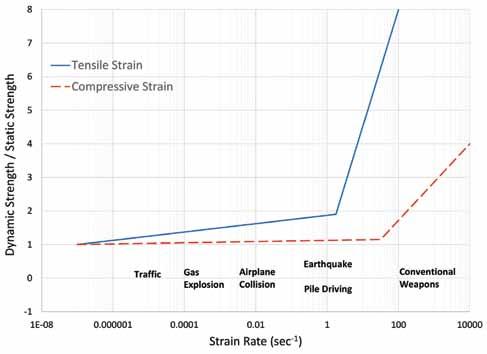
elements to prevent disproportionate collapse due to extreme damage to a localized area of a structure. Exterior building envelope hardening is generally a key consideration for blast-resistant design.
Differences at the Component Level
There are many unique aspects of component-level response that pertain specifically to seismic or blast applications. For instance, strain rates in blast-loaded components can be orders of magnitude higher than those generated during a seismic event. It has been shown through experimental testing that common construction materials, such as concrete and steel, experience strain-rate-dependent dynamic strength increases beyond certain threshold limits. In practice, these apparent strength increases are typically captured through the use of dynamic increase factors (DIF) applied to nominal yield and/or ultimate material strengths. Figure 2 illustrates DIFs for concrete associated with different types of loads. In general, strain-rate effects tend to increase yield and ultimate strengths while reducing material-level ductility. Stiffness remains largely unaffected by strain-rate effects. Also, as can be seen from Figure 2, strain-rate effects for earthquake events are most often negligible and are typically not considered in practice. Structural components respond to seismic excitation in a cyclic manner. A well designed and detailed component will undergo numerous cycles of response without a major reduction in load carrying capacity. For structural components designed specifically for controlled plastic deformation, this sustained fidelity is of utmost importance from both an energy dissipation and a system-level structural integrity point of view. Loss of confinement, local material degradation, excessive rebar strain-penetration at connections, second-order effects due to excessive deflections, local buckling, and fracture are all potential causes for reduced component-level load carrying capacity and should be considered during design. Many of these undesirable limit states can be avoided by ensuring adequate detailing. Because the entire LFRS plays a major role in resisting seismic forces, horizontal elements such as diaphragms, collectors, and their connections are just as (if not
more) important to the structural integrity to the time at which the entire component is set of the entire LFRS as the vertical elements. in motion, and it is chiefly driven by the effects While response to seismic excitation is very of the impinging shock wave as it propagates much a battle of attrition, where attention through the component material and interis paid to hysteretic energy dissipation and acts with cross-sectional bounding surfaces. “riding out” the relatively long duration ground These early-time wave propagation effects motion, response to blast loading is quite dif- can lead to material damage such as spall and ferent. Blast-loaded structural components breach, which can cause locally reduced section undergo a complex response evolution involv- capacity and hazardous secondary blast-borne ing early-time local material response followed fragments before the entire component is even by “global” component response measured in set in motion. Conversely, global component milliseconds. Local material response refers to response refers to dynamic modes of response, early-time material behavior that occurs prior such as flexure and direct shear, which engage TAY24253 BraceYrslfStrctrMag.qxd 9/3/09 10:09 AM Page 1
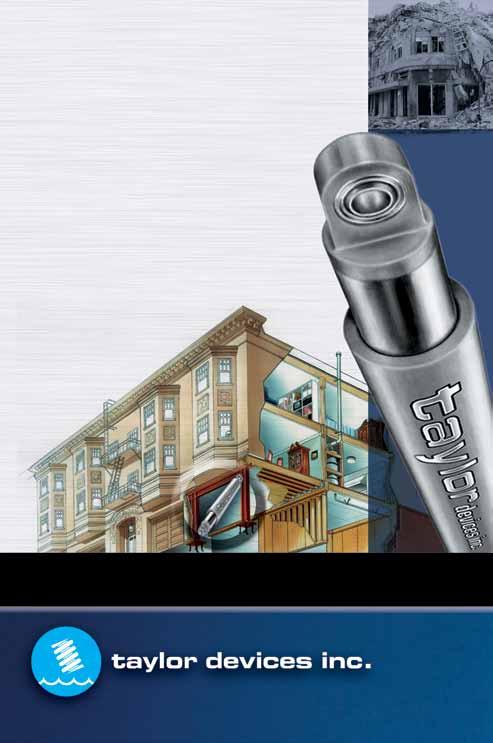
YOU BUILD IT. WE’LL PROTECT IT.
SEISMIC PROTECTION FROM TAYLOR DEVICES
Stand firm. Don’t settle for less than the seismic protection of Taylor Fluid Viscous Dampers. As a world leader in the science of shock isolation, we are the team you want between your structureand the undeniable forces ofnature. Others agree. Taylor Fluid Viscous Dampers are currently providing earthquake, wind, and motion protection on more than 240 buildings and bridges. From the historic Los Angeles City Hall to Mexico’s Torre Mayor and the new Shin-Yokohama High-speed Train Station in Japan, owners, architects, engineers, and contractors trust the proven technology of Taylor Devices’ Fluid Viscous Dampers.
Taylor Devices’ Fluid Viscous Dampers give you the seismic protection you need and the architectural freedom you want.
www.taylordevices.com
North Tonawanda, NY 14120-0748 Phone: 716.694.0800 • Fax: 716.695.6015
the entire component and depend on characteristics such as boundary conditions, stiffness, mass, and blast pulse variation with time. Direct shear behavior is regarded as being independent of flexure and involves large, localized shear forces near component supports that result from high-frequency, multi-modal effects that take place prior to the onset of traditional flexural response. If a blast-loaded component survives the early-time wave propagation effects and is properly designed to resist direct shear forces, it will respond in flexure. Unlike structural response to seismic loads, where cyclic behavior is expected, response to blast loads typically involves a single, high-demand inbound incursion – rebound can also be important for scenarios involving stiff components, interior detonations, or blast pulses with a significant negative phase – followed by numerous cycles of relatively benign free vibration response. The peak deflection during initial inbound response can be very large depending on the desired performance objective, particularly if flexural hinging and perhaps even membrane response are permitted.
Synergies
While design for seismic or blast loads alone does not guarantee adequate performance for both load cases, there are many synergies that exist between these design methodologies. In general, the shared benefits are related to design features implemented to ensure adequate behavior of members and systems loaded beyond their elastic limit. The three primary areas where synergies exist are capacity design, ductile detailing, and design for continuity – all of which are somewhat related. The capacity design methodology focuses on designing connections to allow for structural components to reach their full capacity and deform in a ductile manner up to failure. This precludes connection failure, as well as undesirable component failure modes such as shear and local buckling. In short, capacity design ensures connections are stronger than their connected structural members. Because various elements in the LFRS may be pushed beyond their elastic limit, seismic-resistant design typically requires critical elements (e.g., collector elements) to be connected for the calculated loads factored by an overstrength factor, Ωo, to ensure, indirectly, that the elements are connected to develop their full capacity. In addition, provisions in ASCE 7 Minimum Design Loads for Buildings and Other Structures allow for design of element connections to be based on the capacity of the connected element directly rather than using the calculated seismic forces. Similarly, in blast-resistant design, efficiently designed members will exceed their elastic capacity during response. Therefore, their connections are commonly designed for the full member capacity and/or the peak calculated reaction. In this way, connections of critical members in the force resisting system for blast or seismic will oftentimes be designed for the full capacity of the member, allowing for quick and efficient connection design for both load cases. Ductile detailing, which is intimately related to capacity design, is achieved by designing members to exhibit “ductile” modes of response involving plastic deformations that occur prior to failure and away from connections. This is accomplished through adequate confinement, bracing/stiffening, and overall system connectivity. These are all recommended detailing practices for both seismic and blast design. By designing and detailing for ductility, members and systems can dissipate energy in a predictable and controlled manner without a premature loss in load carrying capacity. Ultimately, this results in reduced connection reactions when compared to a system designed to respond elastically. In addition, ductile detailing increases the robustness of a structural system and can often lead to a more economical design. Adequate connectivity of critical members is also required for most blast-resistant and seismic-resistant design applications. Design for progressive collapse – often termed disproportionate collapse – is frequently required under the umbrella of blast-resistant design. Although, strictly speaking, progressive collapse is regarded as a threat-independent phenomenon. Interested readers can refer to UFC 4-023-03 Design of Buildings to Resist Progressive Collapse for additional information. A fundamental concept of progressive collapse design is ensuring continuity of loadpath-critical framing members and floor slabs to allow the structure to bridge over removed or failed elements, thus maintaining structural integrity and preventing collapse of the structure. Similarly, in order to ensure load path continuity in a seismic-force-resisting system, seismic design typically involves the amplification of design forces for critical members that transfer loads. In addition, special material-specific seismic detailing provisions are typically required in design. For instance, continuity in concrete systems is provided in part by increasing development length, splice length, and hook length requirements for steel reinforcing bars. In steel structures, gravity members are designed for nominal axial loads while connections are designed for the gravity members’ full plastic capacity. In light frame construction, various tie, bond, and anchorage requirements are also specified to achieve continuity. By focusing on the synergies of blast-resistant and seismic-resistant design, more efficient and less costly structures can be designed, detailed, and constructed than would otherwise be achievable by addressing each load case and associated design criteria independently. The Federal Emergency Management Agency (FEMA) has recommended various strategies for leveraging these synergies in design – refer to FEMA reports 439A and P-439B for additional information. In addition, organizations like the MultiDisciplinary Center for Earthquake Engineering Research at the State University of New York at Buffalo have begun to explore multi-hazard design concepts to be implemented for both seismic and blast applications.
Conclusion
As the structural engineering community forges ahead toward enhanced resiliency and security of the nation’s buildings and infrastructure, loads due to earthquakes and blast will continue to be challenging and interdependent facets of building design. It is the hope of the authors that this article was successful in highlighting some of the key similarities and differences between seismicresistant and blast-resistant design, as well as emphasizing the potential benefits of leveraging their synergies in building design.▪
Eric L. Sammarco, P.E., M. ASCE, formerly a Civil Engineer with Black & Veatch’s Nuclear Energy Division, is currently a Ph.D. candidate in Civil Engineering at the University of Texas at Austin. Mr. Sammarco can be reached at esammarco@utexas.edu. Cliff A. Jones, P.E., M. ASCE, formerly a Civil Engineer with Weidlinger Associates, is currently a Ph.D. candidate in Civil Engineering at the University of Texas at Austin. Mr. Jones can be reached at cliffjones@utexas.edu. Eric B. Williamson, Ph.D., P.E., M. ASCE, is the J. Hugh and Betty Liedtke Centennial Professor in Civil Engineering at the University of Texas at Austin. Dr. Williamson can be reached at ewilliamson@mail.utexas.edu. Harold O. Sprague, P.E., F. ASCE, is a Principal Technical Consultant with Parsons. Mr. Sprague can be reached at harold.sprague@parsons.com.
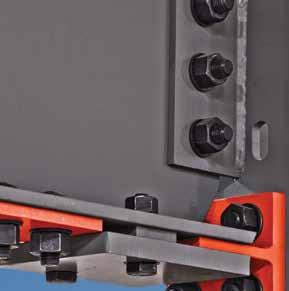

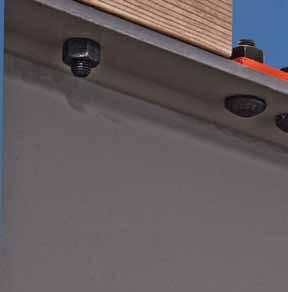
What Gives?
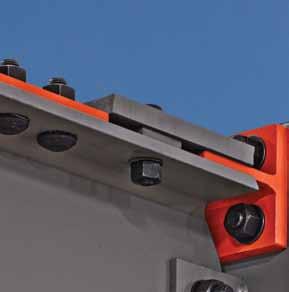
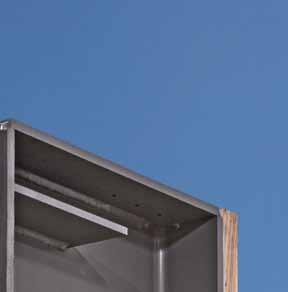
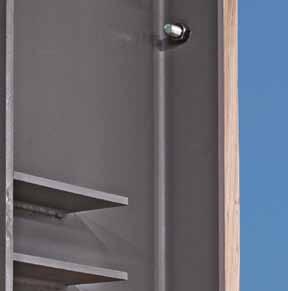


The patented Yield-Link™ structural fuse, that's what.
As the latest innovation from Simpson Strong-Tie, the Strong Frame® special moment frame features four Yield-Link structural fuses that eliminate lateral-beam bracing and are replaceable after a major seismic event. What’s the advantage? It’s easier to specify and it can save building owners signifi cant cost. As with our other moment frames, there is no welding, only bolted connections, and it is designed for wood and steel construction. Learn more by calling (800) 999-5099 or visiting www.strongtie.com/smf.












